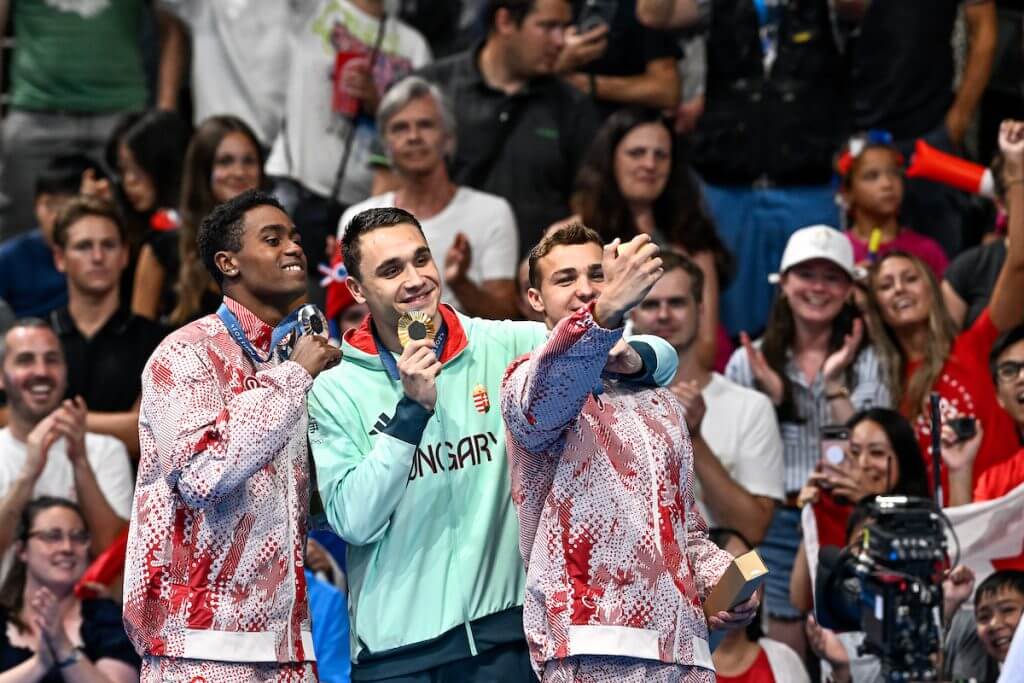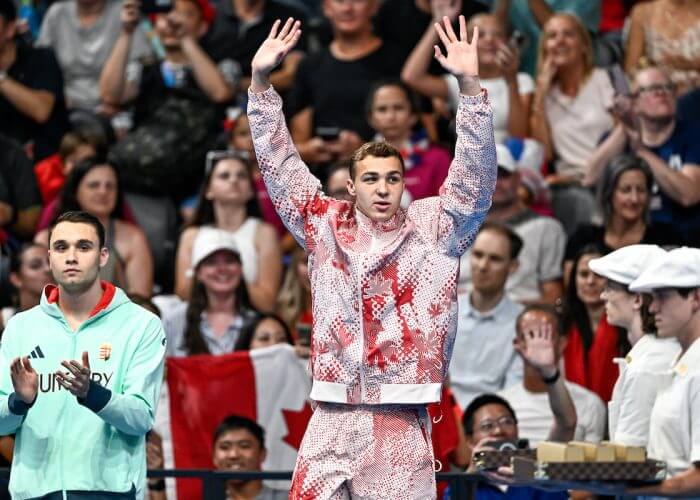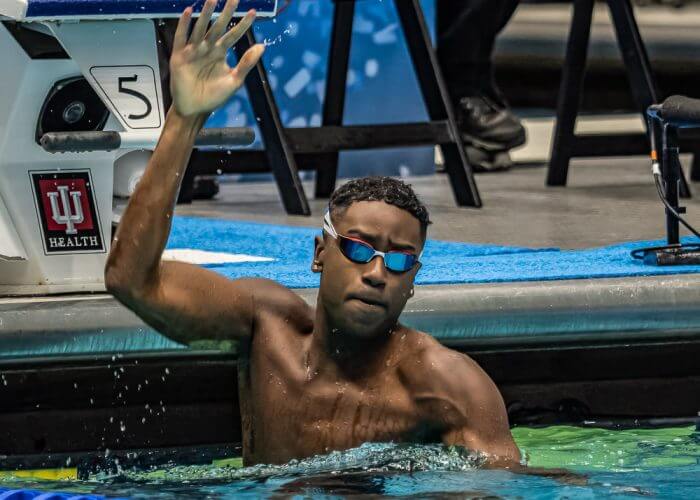Josh Liendo and Ilya Kharun Lighting the Way for Surge by Canadian Men’s Program

Josh Liendo and Ilya Kharun Lighting the Way for Surge by Canadian Men’s Program
What Josh Liendo and Ilya Kharun did in Paris last summer—winning three Olympic medals between them—was historic for a Canadian men’s program that has so long been fallow at the highest levels of international competition.
By the time the second Saturday (Aug. 3) of the Paris Olympics rolled around, Canadian teammates Josh Liendo and Ilya Kharun understood what was possible.
Kharun had already climbed the Olympic podium for a bronze medal in the 200 butterfly behind his ASU college teammate Leon Marchand. Liendo didn’t yet have a medal, but was swimming well, having missed bronze in the 50 free by 2-hundredths of a second in fourth place.
It all fed a sense of possibility—of good form, of good fortune and maybe, just maybe, of history in the making. It was palpable enough for Kharun to verbalize it, even before Liendo’s 50 free: “Me and Josh a couple days ago spoke about how crazy it would be if me and him both got on the podium (in the 100 butterfly),” Kharun said in Paris. “I’m so glad we spoke it into existence. It’s such a great feeling. I was like what if we both get on this podium? It’d be crazy because it’s never been done before.”
The duo would make history at the Paris La Défense Arena, Liendo getting silver behind Hungary’s Kristof Milak, and Kharun following with his second bronze. Between them are plenty of contrasts—from their approach to the event to the paths taken to represent Canada. But their diverse journeys speak to a bright future for the long-dormant Canadian male swimming program.
DIFFERENT PATHS TO THE PODIUM
The three medals that Liendo and Kharun won in Paris last summer equaled Canada’s total from pool competition at the last five Games combined, with Ryan Cochrane’s consecutive medals in the 1500 free in 2008 and 2012 augmenting Brent Hayden’s 100 free bronze in London. (Richard Weinberger also won bronze in the men’s 10K open water marathon in London.)
The last time Canada won more than two pool medals at the same Olympics was 40 years ago at the Eastern bloc-boycotted 1984 Games. Liendo’s silver medal equals Cochrane’s silver in 2012 as the most significant male medal since Mark Tewksbury won the last Canadian gold medal (100 backstroke in 1992). Kharun is the first Canadian man since IMer Curtis Myden in 1996 to leave an Olympics with two medals. It’s just the second time two Canadians have medaled in the same swimming event, joining Cheryl Gibson and Becky Smith in the women’s 400 IM in Montreal in 1976.

Ilya Kharun of Canada celebrates after winning the bronze medal in the swimming 100m Butterfly Men Final during the Paris 2024 Olympic Games at La Defense Arena in Paris (France), August 03, 2024.
Liendo’s and Kharun’s pathways to Paris are as undulating as the stroke that delivered their hardware. Both are the children of immigrants: Liendo born in Toronto to expat Trinidadians, and Kharun in Montreal to touring Ukrainian circus acrobats. Both ramped up to Olympic glory with star turns in NCAA swimming, Liendo at the University of Florida and Kharun at Arizona State.
But the differences are numerous. Liendo was reared in the heart of Swimming Canada’s system, identified as a teen at North York Aquatic Club and brought into the High Performance Centre in Ontario. Kharun famously didn’t know he was Canadian until he rose to the level of international competition, named to Team USA for the Junior Pan Pacific Championships in 2022 before being withdrawn and completing a switch to Canada, the country of his sole citizenship. He is the found money of the Canadian program, having been raised in Las Vegas and reared at Sandpipers of Nevada. It’s not quite a replicable pathway with any consistency for Swimming Canada, but it represents the openness of which such a multicultural nation with cosmopolitan urban centers can avail itself.
Their methods in the pool are different, too. Kharun is a pure butterflyer, the 200 his specialty. He’s added speed in Tempe, working with renowned sprint coach Herbie Behm to become a more versatile racer for all distances. To call Liendo a pure sprinter would be unfair to the technical proficiency and beauty of his butterfly. But he is more at home over shorter distances, and his Olympic program included the 50 and 100 free.
ON THE LEADING EDGE

Courtesy: Peter Bick
Liendo has long been the standard bearer for the men’s program, an odd thing to say about someone who turned 22 just after the Olympics and remains halfway through his college career. A World Junior Championship medalist in 2019, his breakout year was 2022. He finished 2021 with bronze medals in the 50 and 100 free at the World Short Course Championships, then won bronze in the 100 free and 100 fly in Budapest at Long Course Worlds. He also became the Commonwealth Games champion in the 100 fly that summer.
The Tokyo Olympics was a moment of symbolic significance for Canada’s male program. It featured Liendo, born in 2002, and Brent Hayden, who swam at Commonwealths and the Pan Pacific Championships in 2002, on the same medley relay, finishing fourth and setting a Canadian record.
Hayden, who had come out of retirement at age 37, knew then that he was passing the torch to Liendo to lead the program. Liendo has taken on that role not just with his speed in the pool, but with a poise and maturity beyond his years out of it. (One example from Paris: The final of the 50 free and semifinals of the 100 fly fell on the same day, leading Frenchman Maxime Grousset to scratch the former and give Liendo, who had finished ninth in semis, the option to jump into the final. He did—with his response: “It’s an Olympic final, ‘Why not?’”—and nearly nicked a medal.)
Some of that is about being a trailblazer, the first Black Canadian swimmer to medal at the Olympics. He swims at Florida for Anthony Nesty, the Surinamese Olympic gold medalist who in Paris became the first Black coach to lead the U.S. swim team. The consciousness of his position and embrace of the attention that comes with it informs his drive to make sure future generations have a pathway to where he is.
“From the standpoint of me and Ilya, and me being the first Black Canadian (swimmer) to medal at an Olympics, I feel like it is just motivation for the rest of the country and people coming up,” Liendo told Swimming Canada upon being named its Male Swimmer of the Year for a third straight time. “Hopefully, we can inspire the next generation and keep this momentum moving forward in the sport in Canada. I feel like swimming has a lot of room to grow and should be a bigger sport in the country.”
BRIGHTER DAYS
It extends beyond Liendo and Kharun. The Canadian women have been international players for the last three Olympic cycles—from Penny Oleksiak’s gold in Rio on the way to becoming Canada’s most decorated Olympian to World and Olympic titles for Maggie MacNeil and Kylie Masse to the emergence of Summer McIntosh as a genuine teenage superstar.
Progress on the men’s side is more modest, but still steady. The Olympic summer brought national records for Liendo, Kharun, Finlay Knox and Blake Tierney. Knox became a world champion in the 200 individual medley in Doha and remains only 23 years old. Tierney is 22. Liendo leads a five-strong contingent in Gainesville, which includes double Junior Pan Pacs gold medalist Aiden Norman. National teamer Filip Senc-Samardzic is in Tempe with Kharun.
Brighter days are ahead for the Canadian men, with Liendo and Kharun lighting the way.
“It’s a huge momentum shift on the men’s side,” Liendo said of the Paris 100 fly. “It’s just exciting. I think we definitely made a big statement there.”




Ilya Kharun, at 19 years of age, is perhaps the youngest of the top world ranked butterfly swimmers, and likely is a few years away from reaching his full strength and potential. He is also an excellent SCM swimmer as shown by his 200m gold and 50m silver in December at the World SCM Championships.